
A gold rush or gold fever is a discovery of gold—sometimes accompanied by other precious metals and rare-earth minerals—that brings an onrush of miners seeking their fortune. Major gold rushes took place in the 19th century in Australia, Greece, New Zealand, Brazil, Chile, South Africa, California, the United States, and Canada while smaller gold rushes took place elsewhere.

Gravel is a loose aggregation of rock fragments. Gravel occurs naturally on Earth as a result of sedimentary and erosive geological processes; it is also produced in large quantities commercially as crushed stone.

Placer mining is the mining of stream bed (alluvial) deposits for minerals. This may be done by open-pit or by various surface excavating equipment or tunneling equipment.

Hydraulic mining is a form of mining that uses high-pressure jets of water to dislodge rock material or move sediment. In the placer mining of gold or tin, the resulting water-sediment slurry is directed through sluice boxes to remove the gold. It is also used in mining kaolin and coal.

Dredging is the excavation of material from a water environment. Possible reasons for dredging include improving existing water features; reshaping land and water features to alter drainage, navigability, and commercial use; constructing dams, dikes, and other controls for streams and shorelines; and recovering valuable mineral deposits or marine life having commercial value. In all but a few situations the excavation is undertaken by a specialist floating plant, known as a dredger.

Gold mining is the extraction of gold by mining.

A rocker box is a gold mining implement for separating alluvial placer gold from sand and gravel which was used in placer mining in the 19th century. It consists of a high-sided box, which is open on one end and on top, and was placed on rockers.
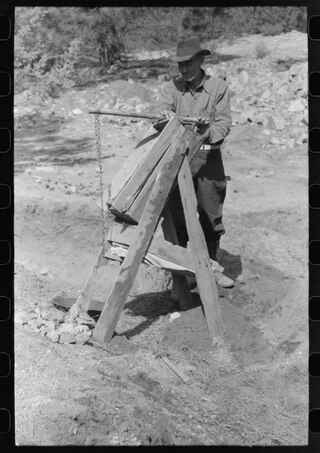
A drywasher is a common desert mining tool for gold mining.
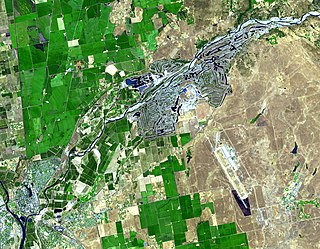
The Yuba Goldfields, also known as the Hammonton dredge field, is the largest gold dredge field in California. Located along the Yuba River approximately 6–12 miles (10–20 km) upstream of the town of Marysville, in Yuba County, the Hammonton dredge field was actively dredged for gold from 1904 to 1968. In total, more than one billion cubic yards of river sediment and lesser hydraulic mining debris was dredged to produce an estimated 5.14 million ounces of gold. The goldfields are noted for their otherworldly appearance, filled with roughly linear mounds of gravels, ravines, streams and turquoise-colored pools of water. From the air, the goldfields are said to resemble intestines.

Gold became highly concentrated in California, United States as the result of global forces operating over hundreds of millions of years. Volcanoes, tectonic plates and erosion all combined to concentrate billions of dollars' worth of gold in the mountains of California. During the California Gold Rush, gold-seekers known as "Forty-Niners" retrieved this gold, at first using simple techniques, and then developing more sophisticated techniques, which spread around the world.
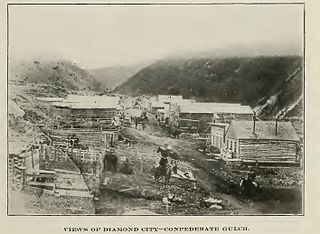
Confederate Gulch is a steeply incised gulch or valley on the west-facing slopes of the Big Belt Mountains in the U.S. state of Montana. Its small stream drains westward into Canyon Ferry Lake, on the upper Missouri River near present-day Townsend, Montana. In 1864, Confederate soldiers on parole during the American Civil War made a minor gold discovery in the gulch, but the discovery of the sensationally rich Montana Bar the following year—one of the richest placer strikes per acre ever made—led to other rich gold strikes up and down the gulch, and touched off a frantic boom period of placer gold mining in the area that extended through 1869. From 1866 to 1869, the gulch equaled or outstripped all other mining camps in the Montana Territory in gold production, producing an estimated $19–30 million worth of gold. For a time, Confederate Gulch was the largest community in Montana. In 1866, Montana had a total population of 28,000, and of these, about 10,000 (35%) were working in Confederate Gulch.

The Nome Gold Rush was a gold rush in Nome, Alaska, approximately 1899–1909. It is separated from other gold rushes by the ease with which gold could be obtained. Much of the gold was lying in the beach sand of the landing place and could be recovered without any need for a claim. Nome was a sea port without a harbor, and the biggest town in Alaska.

Choie Sew Hoy also known as Charles Sew Hoy was a New Zealand merchant, Chinese leader, gold-dredger and a New Zealand Business Hall of Fame laureate. He was born in the village of Sha Kong in the Poon Yu District of Guangdong Province, China in about 1838.
Shovel Creek is a waterway in the U.S. state of Alaska, near Nome. It flows into Solomon River from the west about 4 miles (6 km) from the coast. It heads in a divide about 2 miles (3 km) from the Casadepaga River and flows nearly southward to its junction with Solomon River. Although not a very long stream, it has a large drainage area and carries during ordinary seasons about 500 inches (1,300 cm) of water. It has a gradient of about 100 feet per mile (19 m/km). Through the greater part of its course, it spreads over wide gravel bars. The bed rock of the Shovel Creek basin consists for the most part of limestones and calcareous mica schists. Near the head of the creek, there are some intrusions of greenstone. Mining operations in the Shovel Creek basin occurred at three small tributaries—Mystery, West, and Kasson creeks.

Palmer River Gold Company Dredge is a heritage-listed dredge on the Palmer River at Strathleven, Palmer, Shire of Cook, Queensland, Australia. It was built from 1930 to c. 1935. It was added to the Queensland Heritage Register on 17 June 2003.

Nettle Creek Tin Dredge is a heritage-listed dredge at Nettle Creek, Innot Hot Springs, Tablelands Region, Queensland, Australia. It was built in 1957. It is also known as Barrytown 2 Dredge, Barrytown Gold Dredge, and Battle Creek Tin Dredge. It was added to the Queensland Heritage Register on 22 September 1995.

Dredge No. 4 is a wooden-hulled bucketline sluice dredge that mined placer gold on the Yukon River from 1913 until 1959. It is now located along Bonanza Creek Road 13 kilometres (8.1 mi) south of the Klondike Highway near Dawson City, Yukon, where it is preserved as one of the National Historic Sites of Canada. It is the largest wooden-hulled dredge in North America.
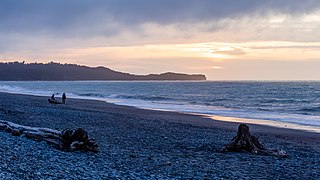
Gillespies Beach is a black sand beach and settlement on the West Coast of New Zealand's South Island, 20 kilometres (12 mi) west of Fox Glacier township by road. It is bounded by Westland Tai Poutini National Park to the east, and the Tasman Sea to the west. The beach itself stretches about five kilometres (3.1 mi) from Gillespies Point / Kōhaihai in the north to Otorokua Point in the south.
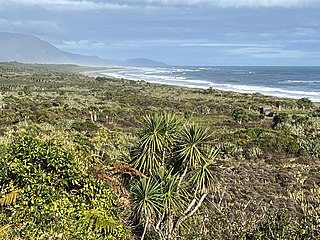
The Barrytown Flats are a 17 km (11 mi) coastal plain north of Greymouth on the West Coast of New Zealand's South Island. A series of postglacial shorelines and dunes backed by a former sea cliff, they was originally covered with wetland and lowland forest, including numerous nīkau palms. The sands were extensively sluiced and dredged for gold from the 1860s, centred on the small settlement of Barrytown. The drier areas of the flats have been converted into pasture, but significant areas of forest remain, including Nikau Scenic Reserve. The flats are bordered by Paparoa National Park and the only breeding site of the Westland petrel. There are significant deposits of ilmenite in the Barrytown sands, and there have been several mining proposals, but the possible environmental consequences have been contentious.






















